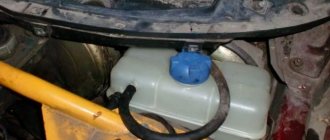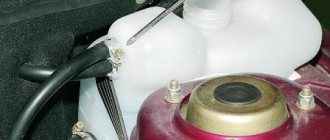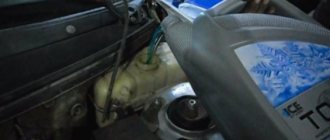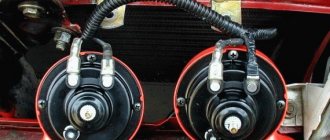The normal functioning of the power unit directly depends on the proper operation of the cooling system. If problems arise with the latter, then the temperature regime of the engine is disrupted, which leads to various malfunctions. To avoid engine breakdown and failure of cooling system elements, the liquid level in the expansion tank must be regularly monitored and, if it decreases, any malfunctions must be found and corrected.
- Burnout of the cylinder head gasket
Video: reasons for squeezing antifreeze into the expansion tank
- Troubleshooting Methods
Video: how to get rid of air in the cooling system
What to do if the antifreeze is knocked out
First of all, it is necessary to localize the location of the leak.
Perhaps you will find the reason there. Most often (especially on cars with high mileage), flange connections simply collapse or hoses burst. High pressure coupled with temperatures under 100 °C will easily squeeze out an element worn out from age. After replacing a faulty unit, be sure to check the operation of the valve on the expansion tank cap. The valve on the cover cannot be restored, so the element must be replaced. If it can be disassembled, check the integrity of the spring and membrane. In some cases, removing dirt and crystals from mineral supplements is sufficient.
The gaskets are replaced with new ones; no restorative sealants will withstand pressure at high temperatures.
Heating devices
In systems with natural circulation, you can use only radiators, as well as thick pipes as radiators (they have less hydraulic resistance).
But, alas, you cannot use convectors - natural circulation simply will not flow through them.
To summarize the above, an open system is a thing of the past. Slow heating, high inertia of the system, a large amount of soluble air, bulky pipes, and low efficiency make it unattractive for modern heating systems. So it is used in extreme cases - for example, in areas where electricity is often cut off.
The most popular now are closed systems with forced circulation of coolant, two-pipe or collector-beam.
Main reasons
Expansion tank cap
There are several main reasons for the release of coolant through the expansion tank.
They are divided into several groups depending on what exactly the problems are associated with.
Similar phenomena occur on a variety of vehicles, including:
- VAZ 2114;
- Gazelle;
- KAMAZ;
- DAF;
- Lada Kalina;
- Nissan Almera;
- Mitsubishi Lancer;
- Hyundai Accent;
- Volkswagen Polo;
- Nissan Qashqai;
- Daewoo Lanos;
- Lada Granta;
- Mazda 6;
- Mercedes;
- Audi A5, etc.
The likelihood of encountering a similar problem is higher for cars with a higher mileage. Although we cannot rule out antifreeze emissions from cars that were only recently purchased and put into operation.
Let's look at the possible reasons separately.
Tank malfunctions
At first it may seem that the tank is designed extremely simply, and there simply cannot be any significant problems with it.
But it is because of the tank that the coolant most often begins to eject.
The seal is broken. Antifreeze has a high fluidity, which is why it can penetrate even through small cracks that are not visually noticeable. Thus, when the pressure increases, the liquid is squeezed out. Check for stains under the car after parking. It is best to completely replace the tank if there is leakage;
Defective threaded connections
When checking the expansion tank cap, pay attention to the threads of the neck and the valve itself. Cheap and low-quality products often have burrs and chips, which make a tight fit impossible.
An increase in pressure provokes coolant leakage through these channels;
Valve. The valve cover is also a common cause of fluid leaking from the reservoir. Moreover, the problem is quite easy to identify. Everything works fine at idle. But by increasing the speed, under load, the liquid is literally pushed out from under the valve. First try to disassemble and clean the element. If this does not help, the valve needs to be replaced.
But these are not the only possible reasons. Let's move on in search of the truth.
Coolant circulation is impaired
If circulation is disrupted, the fluid overheats greatly, pressure increases and coolant is squeezed out through the valve cover.
There are several reasons here.
The potential reasons don't end there
There is one more important point that is worth paying attention to
Leak formation
Most often, motorists are faced with a shortage of coolant in the cooling system. When the volume of antifreeze drops, the temperature rises as the engine cools. Heating leads to active evaporation and an increase in pressure.
If, when the engine cools down, the level remains unchanged in the tank, then you need to look for a problem in the circulation. And when the level drops, then the seal is broken. That means there is a leak somewhere.
There are several main probable causes of leakage:
- The pipes and hoses of the system are worn out and aged. They will need to be replaced, strengthening the new parts with additional clamps to increase the reliability of the connections;
- Cracks in the heater cores and cooling system. If the problem is in the stove, then antifreeze will leak into the cabin. Usually at the front passenger's feet;
- Problems with the pump and thermostat seals. Look for traces of antifreeze near those elements that act as suspects;
- The cylinder head gasket is broken. In this case, the cylinder head gasket will need to be replaced. The danger is that the coolant can penetrate the engine cylinders or lubrication system, mixing with the oil. The consequences can be extremely disastrous for the engine, including jamming of the internal combustion engine.
Now you are clearly convinced that there is nothing good in throwing out antifreeze through the expansion tank. When the first signs appear, be sure to stop the car, start looking for the causes and eliminating them.
If you have any difficulties with diagnostics or repairs, you can always contact a car service center.
Thanks everyone! Subscribe, invite your friends to join us and expect a lot of new and useful materials!
Lift kit for Niva: which one to buy and how to install it yourself
- Thermostat is faulty. If it does not work, then the liquid will flow only in a small circle, bypassing the antifreeze cooling radiator. In this situation, the motor will overheat. It is necessary to check and, if necessary, change the unit;
- Air lock or clogged channels. Blockages appear due to scale, mechanical debris, improper mixing of antifreeze, etc. This is where the radiator is cleaned and flushed;
- Water pump failure. I have already talked about the signs and causes of a malfunctioning water pump in a separate article. Just follow the link.
The potential reasons don't end there. There is one more important point that is worth paying attention to.
Leak formation
Most often, motorists are faced with a shortage of coolant in the cooling system. When the volume of antifreeze drops, the temperature rises as the engine cools. Heating leads to active evaporation and an increase in pressure.
If, when the engine cools down, the level remains unchanged in the tank, then you need to look for a problem in the circulation. And when the level drops, then the seal is broken. That means there is a leak somewhere.
Why does antifreeze squeeze out of the expansion tank?
G12 antifreeze, its features and differences from other classes of antifreeze
Often car owners are faced with the fact that antifreeze begins to squeeze out of the expansion tank. In this case, no visible reasons can be found (the pipes and the cover are intact, and after a long period of parking, no puddles appear under the car). In this case, you can diagnose what antifreeze is emitting through the expansion tank by measuring the refrigerant level or checking the following elements in a given order:
- expansion tank;
- engine radiator;
- stove radiator;
- thermostat housing;
- all possible joints and pipes;
- cooling system pump.
If antifreeze leaks, the causes and consequences may be more serious than it seemed, so it would not be superfluous to check the engine oil. A probe is used for this. If traces of light foam remain on it, this indicates that the refrigerant is mixed with oil.
If antifreeze goes into the engine, then you will find white spots on the spark plugs.
Upon closer examination, you will be able to identify one of the causes of leaks that form in different components.
Cooling system radiator
Carefully inspect the engine (it is better to wash the entire engine compartment first). One of the most common reasons is a leak in the cooling system components. In this case, the location of the problem is the radiator, which may have been pierced by a stone or other object thrown from under the wheels of oncoming traffic. If antifreeze is leaking from the radiator, then the plates are probably worn out, which were exposed to ethylene glycol, which is part of the antifreeze, for a long time. Or the tank itself is simply cracked, in which case it is enough to replace it with a new one. Some radiators are equipped with plastic tanks, in which cracks quickly form and, as a result, liquid leaks.
Heater radiator
If the radiator of the heating system is responsible for the leak, then a clear “aroma” appears in the car’s interior. In some situations, you may also find a sticky spot under the dashboard.
Important! If you begin to smell an unpleasant odor, solve the problem immediately, since refrigerant vapors are very harmful to the human body, especially if the antifreeze is made on the basis of ethylene glycol.
water pump
Another reason why antifreeze is thrown out of the expansion tank may be the pump, or more specifically, a worn out oil seal. It is very easy to identify this “disease”. To do this, carefully inspect the engine and if you find that there are wet areas in its lower part, then the “hero of the occasion” is definitely the pump.
Thermostat
A broken thermostat seal is also a possible cause of problems. In most cases, normal gasket wear occurs.
In addition to the loss of refrigerant, car owners are faced with other problems.
Remedies
Before starting repairs, you should figure out where and why the antifreeze is leaking, that is, make a diagnosis. Leaking hoses are easy to identify, as are fluid emissions from the tank - colored streaks are visible in the area of the lid. It’s more complicated with radiators - the holes in the pipes are usually small, they are blown by an air flow as they go, and leaks are invisible at first glance.
Advice. Fill the car's cooling system with antifreeze containing a fluorescent additive. It reflects the light of an ultraviolet lamp, making the slightest drips clearly visible.
Various problems can be resolved in the following ways:
- Try to clean and rinse the faulty valve of the expansion tank plug. If this does not help, the part should be replaced; it is inexpensive.
- A burst tank should be replaced. There is a practice of repairing plastic containers by soldering, but this option is not very reliable - the body may crack with the next pressure surge.
- Leaking hoses are definitely replaced. The exception is a crack at the very end, then the pipe is trimmed (if the length allows).
- A leaky pump seal must be replaced only on old Zhiguli VAZ 2101–07. On other cars it is replaced together with the water pump.
- Car radiators can be repaired if the cracks in the honeycombs are not the result of corrosion of the aluminum alloy. In any case, the unit must be removed and taken to a service center for inspection.
- A broken cylinder head gasket must be replaced immediately; you cannot drive with this damage. The work involves disassembling the engine; it should be entrusted to a master mechanic.
Burst of hoses and damaged pipe is a problem that requires quick fix
What antifreeze to choose, choice by car make, orange antifreeze
For old cars with hundreds of thousands of miles on them, the problem of antifreeze leakage is most often worn out hoses. Over time, they lose their elasticity, crack and no longer withstand constant pressure. Its fastening at the junction also loses strength and weakens, which can lead to antifreeze leakage.
Advice! For preventive purposes, it makes sense to change the cooling system hoses after about 5 years of operation (for foreign cars - 10 years), and use screw clamps for fastening.
It is not difficult to find out that the hoses are the reason why the antifreeze quickly disappears. A careful inspection is enough. If obvious damage is clearly visible, then in order to identify small defects, you must first thoroughly rub all the hoses with a dry rag and run the engine at idle speed. After this, coolant leaks become clearly visible.
In some cases, it is necessary to carry out an operation to replace worn pipes. When performing this procedure yourself, you should follow certain recommendations:
- The car engine must cool completely;
- It is better to use a clean container to drain antifreeze, since it can be reused and can be poured back into the system;
- to make it easier to unscrew the clamps, you can lubricate them with a small amount of liquid oil or another product (for example, WD-40);
- after loosening the clamps, the pipe is carefully removed from the neck, remembering that almost all necks are quite fragile and easily damaged;
- Before putting on a new pipe, clamps are put on it;
- if difficulties arise when tightening a new pipe, you should not use any chemicals, it is only permissible to hold the pipe in hot water;
- The clamps are tightened tightly.
Circulation pump
It should be located so that natural circulation is possible in case of an emergency power outage.
The pump is located on a branch from the main supply pipe. Normally, ball valve 1 on the supply pipe is closed, and the circulation pump operates, pumping water into the heating system.
But when there is a power outage, the pump stops working. In this case, Ball Valve 1 is opened and water begins to circulate through the system by gravity, of course more slowly.
But a person is needed to shut off ball valve 1! Therefore, a check valve with expansion is usually installed instead. In such a check valve, the hydraulic resistance is much less than in a classic one.
What to do if antifreeze boils
If you notice that the antifreeze has begun to boil, it is better to identify the root cause as quickly as possible, as this will have a detrimental effect on the operation of the engine. Although the boiling point of antifreeze is higher than the boiling point of water, the refrigerant still periodically fails to cope with too heavy loads
There can be many reasons for this, for example:
- The coolant level has dropped to a minimum due to which the antifreeze in the expansion tank is boiling. In this case, it is enough to add refrigerant or water.
- The thermostat can also cause boiling if the valve that passes fluid through a large circle of the cooling system is broken. In this situation, it turns out that the antifreeze moves only in a small circle and does not physically have time to cool down, as a result of which it heats up to a high temperature and begins to boil. To identify such a problem, you need to check the temperature of two pipes; if one of them is cold and the other is hot, then the problem is clearly in the thermostat. A thermostat malfunction is a very serious failure, since when antifreeze circulates only through a small circuit, not only the antifreeze, but also the engine itself heats up, and this threatens to jam the piston group.
Advice! If the thermostat “flies” outside the city and there is no way to replace it, you can continue driving in small sections of 5 kilometers. After each section, allow the engine to cool completely.
- Problems that cause antifreeze to boil often lie in the radiator. The temperature of the antifreeze can reach the boiling point if the refrigerant forms sediment, resulting in clogging of the tubes. As a result, the large cooling circuit turns into a small one. It will be difficult to get rid of such a problem on your own, so it is better to contact a repair shop.
- The pump can also be fully responsible not only for the leak, but also for the boiling of antifreeze. If this element is completely out of order, then the refrigerant cannot fully move through the cooling system. As a result, the liquid boils and the motor overheats greatly.
Description of an open type heating system: what is it?
The OS heating circuit consists of a boiler located at the lowest point of the building - the basement or pit.
A vertical coolant supply riser extends from the boiler to the top point of the building (attic or attic), where the expansion tank (RB) is located.
Horizontal pipes with a slight slope extend from the RB along the top of the building to vertical risers, through which the coolant is delivered to the radiators.
The return line runs from the heating appliances at the bottom of the room, also with a slight slope towards the boiler.
A little about the problem
The expansion tank is an integral component of the internal combustion engine cooling system. The main task of this element is to dampen pressure fluctuations inside pipelines that arise as a result of a decrease or increase in the volume of cooling liquid when it is cooled and heated, respectively.
Such a capacity allows you to reduce mechanical loads on the entire cooling system. Thus, the internal combustion engine is protected from water hammer and air locks. Although they cannot be completely prevented, as a result, sometimes you have to figure out how to remove the airlock. Essentially, the tank replenishes the liquid deficit in the cooling lines and acts as a receiving tank when excess coolant appears, which occurs when the composition is heated. Structurally, it is a seemingly ordinary sealed plastic tank.
An integral element of the unit is the expansion tank cap, which also serves as a valve. With its help, pressure enters the tank from the outside when there is a deficiency in the system, or excess pressure is released.
When the coolant heats up, the liquid gradually expands, thereby filling the tank space. In parallel with the increase in evaporation from heating, the internal pressure increases.
For various tank designs and specific car engines, along with their cooling system, certain threshold pressure values are provided. When they are reached, a valve begins to operate, which expels excess pressure from the system. But there are situations when the antifreeze is already boiling, the pressure increases, but it does not release. Instead, it throws out the liquid itself. That is, the valve does not cope with its tasks. Why this happens and how to deal with it is the key question of this material.
Moreover, emissions can appear after the engine is stopped and during operation of the power plant. Let's understand the reasons.
Installation of an open heating system: photo
Before installation, it is necessary to perform a radiator calculation, a hydraulic calculation of the circulation pressure , develop an installation diagram, and draw up a list of materials and components.
Photo 1. Heating gas boiler of steel color, floor type, installed in a room with all equipment.
The OS consists of the following elements:
- Heating boiler - gas or solid fuel.
- Pipes.
- Expansion tank.
- Radiators.
- Fittings (taps, boiler piping, valves).
- Circulation pump (optional).
Some tips on what to do if antifreeze boils on the road
How to fix an antifreeze leak, if you find yourself in the middle of a highway or there is no car service or auto parts store nearby, the first thing that comes to mind is to add water to the antifreeze. This can really save the situation, but you need to be extremely careful with this operation. Never open the expansion tank cap until the engine has completely cooled down. Otherwise, boiling liquid may splash onto your hands and body, causing severe burns.
If while driving you notice a jump in the antifreeze temperature, you can temporarily solve this problem without stopping. To do this, you need to cool the car interior as much as possible by opening the windows and turning on the heater fan. Thanks to this, you will be able to slightly lower the temperature of the antifreeze and reduce the load on the engine.
If the overheating light starts blinking and the temperature rises to a critical point, it is better to stop immediately and prevent the engine from boiling. It is not recommended to move further in such a situation; wait for a tow truck or ask someone to take you in tow.
An open heating system with natural circulation has a number of features:
- There is a lot of dissolved air in the system, which can lead to corrosion of internal metal elements in the system.
- Great inertia of the system. After turning on the heating, the house heats up slowly. The system must be warmed up gradually, otherwise the water will simply boil in the boiler, while it will still be cold in the radiators.
- The house warms up evenly
- Large temperature difference between supply and return
- Fuel consumption is higher (low efficiency) than in a closed system with a circulation pump
- Independence from electricity
- The system is simple, there is practically nothing to break in it. Fairly simple installation.
- Aesthetically not very good, because... large diameter pipes are used, and sometimes pipes of increased diameter are used as radiators
- The system is quite cumbersome
- Antifreeze cannot be used in the system.
- The water from the system gradually evaporates, so it must be added periodically. It is advisable to install automatic topping up.
- The boiler must be installed at the lowest point of the system. The best place is in the basement, or in some kind of recess.
- The expansion tank is installed at the highest point of the system. If you install it in the attic, it must be insulated.
- Quiet operation due to the absence of a circulation pump
But nevertheless, this system has been successfully used and is used when installing heating in small private houses with a height of 1 or 2 floors.
Let us describe the entire system in order:
How to remove an air lock from the cooling system Simple methods
- After filling or adding new fluid;
- Due to depressurization of connections or pipes of the cooling system;
- The seal of the pump is broken due to worn seals and gaskets;
- Sticking air valve in the expansion tank;
- Mechanical damage due to an accident or traffic accident;
- Deformation of the polymer material due to constant elevated temperature;
- The cylinder head gasket has blown.
Drive the car onto a flat surface or inspection hole, squeeze the handbrake, turn on neutral; Using a jack, lift the front of the car about 35-45 cm from the surface; Open the expansion tank cap
Be careful, as careless handling may result in burns; Start the engine and stove radiator with the temperature set to maximum; Carefully begin adding antifreeze or antifreeze to the expansion tank to the maximum; Increase engine speed to 3000 rpm; Wait until the thermostat opens and begin to squeeze the lower pipe leading to the radiator with your hand. Be careful, carry out the procedure with gloves, following safety rules; Continue doing this until you are sure that the liquid coming out of the expansion tank is clean, without air bubbles; Check the entire lower part of the pipes with your hands, make sure they are hot; Start the stove heater with radiator
Check the supply of hot air flow into the car interior; Lower the car from the jack, secure it with boots for safety; Add the missing amount of refrigerant at a level above average. Never fill at the top level as this may cause expansion and overflow of the lid. Antifreeze particles will corrode the car's paintwork over time; If the airiness is severe, a repeat procedure may be necessary. See this for yourself.
- Drive the car onto a flat surface or inspection hole, squeeze the handbrake, turn on neutral;
- We do not turn off the engine, but warm it up to a temperature of 90°C when the thermostat opens and the liquid begins to circulate in a large circle;
- Do not open the expansion tank cap;
- We turn off the engine;
- Loosen the clamp on the throttle body pipe and remove the pipe. Be very careful and attentive, as temperatures above 90°C can cause burns. Carry out work only with rubber gloves;
- Having removed the rubber hose, wait until all the air mixed with antifreeze or antifreeze comes out of it;
- We put the pipe back on, clamp the clamp;
- We start the engine and test the car. It is advisable to drive both on the highway and around the city at low speed to recheck the system in full.
AutoFlit.ru
Consequences of throwing away antifreeze
If you do not take any measures to eliminate the malfunction and continue driving, the consequences of such driving can be quite serious. If the antifreeze is squeezed out of the tank to a level below the minimum, the engine will simply overheat.
The consequences of engine overheating are very sad. As a rule, the cylinder head gasket is the first to suffer. It consists of a material that is susceptible to high temperatures and burns through, losing its properties. Antifreeze gets into the engine crankcase and makes the oil too liquid. Such a mixture will no longer be able to provide reliable lubrication of the components and then jamming of the mechanism or water hammer occurs.
If the coolant is completely squeezed out, the engine oil will not be affected. However, many elements of the cylinder head can react negatively to an increase in temperature, which become deformed and disrupt the operation of the mechanism. As a result, the engine loses its power or does not start at all and then it will require expensive repairs.
What kind of liquid is in the expansion tank?
Inexperienced motorists may not know what an expansion tank is and what the specific color of liquid with which it is filled is needed for.
Antifreeze, or antifreeze as everyone also calls it, is a liquid that is designed to maintain a comfortably low temperature inside a car engine. Protects internal parts and systems from corrosion, overheating, rust and freezing. That is, it maintains the normal operation of the vehicle.
If antifreeze is released from the expansion tank, the engine and many other vehicle systems will not be able to operate normally.
In the article we will look at the main reasons, consider the signs of fluid ejection and, accordingly, tell you what you need to pay attention to so that your car is always in good condition and does not let you down at the most unexpected moment.
Antifreeze goes away - causes and troubleshooting
Sooner or later, owners of used cars have to deal with a malfunction such as a fluid leak from the engine cooling system. In order to detect such problems in time and successfully eliminate them, you need to understand why antifreeze is released through the expansion tank and for what reason its level constantly drops below the minimum. Sometimes this phenomenon indicates a critical malfunction of the power unit, so it is important to deal with the problem as soon as possible.











